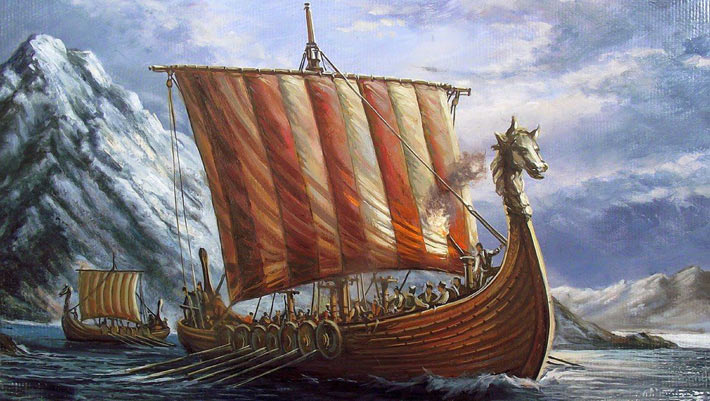The first records of Greenland Vikings date to 985 CE. Archaeological evidence yields insight into how they lived, yet drivers of their disappearance in the 15th century remain enigmatic. Hypotheses include combinations of environmental change, social unrest, and economic disruption. Occupation coincided with a transition from the Medieval Warm Period (900 to 1250 CE) to the Little Ice Age (1250 to 1900 CE) and Southern Greenland Ice Sheet advance. New research demonstrates that this advance would have driven local sea-level rise of 3 m and inundation of 204 square km; this process led to the abandonment of some sites and pervasive flooding; progressive sea-level rise impacted the entire settlement and may have acted in tandem with social and environmental factors to drive Viking abandonment of Greenland.
Sea-level rise may have acted in tandem with social and environmental factors to drive Viking abandonment of Greenland. Image credit: Oscar C.R.
Southwestern Greenland was settled by Norse immigrants in 985 CE when Erik the Red was exiled from Iceland for manslaughter (c. 982 CE) and relocated West.
Erik’s family and other colonizers established the Eastern Settlement and the Western Settlement, which remained until the disappearance of Vikings in the 14th and the mid-15th century, respectively.
The first records of the Norse in Greenland come from both the Book of Icelanders and the Saga of Erik the Red.
Life in the settlements was inherently tied to the land, religious practices, and social standing, closely mirroring the Icelandic Norse colonies.
Archaeological evidence for Viking occupation includes ruins, middens (trash heaps), as well as human and animal bones.
The last written evidence of Norse habitation in Greenland is a record of a wedding ceremony at Hvalsey Church in the Eastern Settlement in the early 15th century, and radiocarbon dates indicate a further half century of occupation.
“There are many theories as to what exactly happened to drive the Vikings from their settlements in Greenland,” said lead author Marisa Borreggine, a doctoral candidate at Harvard University.
“There’s been a shift in the narrative away from the idea that the Vikings completely failed to adapt to the environment and toward arguments that they were faced with a myriad of challenges, ranging from social unrest, economic turmoil, political issues, and environmental change.”
“Sea-level change is an integral, missing element of the Viking story,” added Pennsylvania State University’s Professor Richard Alley, senior author of the study.
“Changing sea level has always affected people, and it will continue to do so.”
“Today, far more people are now vulnerable to rising seas in a warming world,” he said.
“To help these people, we will need a better understanding of the big drivers of sea-level rise, including melting ice, expanding ocean waters and ‘mining’ of groundwater by pumping out more than is returned.”
“But these must be combined with knowledge of local conditions, as was done in this study, because some coasts are more vulnerable than others.”
“The cause of the Viking abandonment of Greenland is not fully understood.”
It was likely due to a combination of factors, but the authors found that the period coincides with a time of great climatic shift, from the Medieval Warm Period to the Little Ice Age in which the Southern Greenland Ice Sheet readvanced, growing larger and taking up more of the island’s landmass.
Using geophysical modeling, they demonstrated that the readvance of the ice sheet would have driven up local sea-levels by roughly 3 m.
They found that the readvance would have caused sea-level to rise near the ice margin due to increased gravitational attraction toward the ice sheet and the Earth’s crust settling.
“The readvance pushed down the land around it, something like the dent that forms around you if you sit on a waterbed; less intuitively, the mass of ice is so large that it significantly attracts the ocean to it. The greater ice mass close to the shore raised the ocean,” Professor Alley said.
Such a dramatic change in sea-level over a relatively short period of time would have made settlements close to the ice margin especially vulnerable to gradual flooding and loss of habitable land.
Analyses of human and animal remains from the region show that beginning in the early 12th century, Vikings may have gradually transitioned their diet from a majority of land-based livestock to marine-based animals like fish and seal.
“Much like modern impacts from climate change, the sea-level rise experienced by the Vikings was compounded by physical and social stressors,” Borreggine said.
They would have experienced increased vulnerability to storms, coastal erosion and disrupted drainage compounded by the physical changes to their environment.
Socially, they would have experienced a dramatic shift in resources, evolving to rely on marine over terrestrial sustenance over time.
While there are modern parallels, there is one critical difference between the climate changes experienced by the Vikings and society today.
“The Vikings didn’t really have a choice,” Borreggine said.
“They couldn’t stop the Little Ice Age. We can do work to mitigate climate change. The Vikings were locked into it.”
A paper describing the results was published in the Proceedings of the National Academy of Sciences.
_____
Marisa Borreggine et al. 2023. Sea-level rise in Southwest Greenland as a contributor to Viking abandonment. PNAS 120 (17): e2209615120; doi: 10.1073/pnas.2209615120




